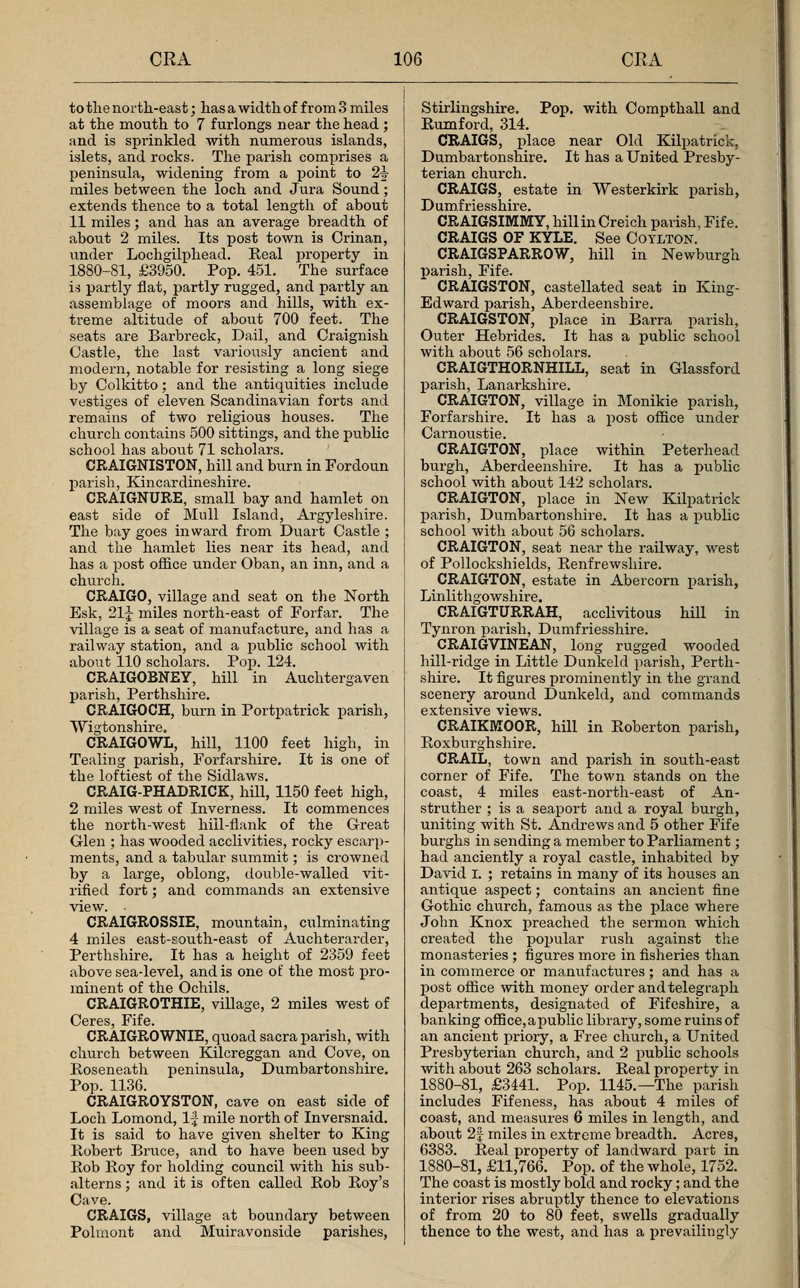CRAIGNISTON, hill and burn in Fordoun parish, Kincardineshire.
CRAIGNURE, small bay and hamlet on east side of Mull Island, Argyleshire. The bay goes inward from Duart Castle ; and the hamlet lies near its head, and has a post office under Oban, an inn, and a ] church.
CRAIGO, village and seat on the North Esk, 21 miles north-east of Forfar. The village is a seat of manufacture, and has a railway station, and a public school with about 110 scholars. Pop. 124.
CRAIGOBNEY, hill in Auchtergaven parish, Perthshire.
CRAIGOCH, burn in Portpatrick parish, Wigtonshire.
CRAIGOWL, hill, 1100 feet high, in Tealing parish, Forfarshire. It is one of the loftiest of the Sidlaws.
CRAIG-PHADRICK, hill, 1150 feet high, 2 miles west of Inverness. It commences the north-west hill-flank of the Great Glen ; has wooded acclivities, rocky escarpments, and a tabular summit ; is crowned by a large, oblong, double-walled vitrified fort ; and commands an extensive view.
CRAIGROSSIE, mountain, culminating 4 miles east-south-east of Auchterarder, Perthshire. It has a height of 2359 feet above sea-level, and is one of the most prominent of the Ochils.
CRAIGROTHIE, village, 2 miles west of Ceres, Fife.
CRAIGROWNIE, quoad sacra parish, with church between Kilcreggan and Cove, on Kosenoath peninsula, Dumbartonshire. Pop. 1130.
CRAIGROYSTON, cave on east side of Loch Lomond, If mile north of Inversnaid. It is said to have given shelter to King Kobert Bruce, and to have been used by Rob Roy for holding council with his subalterns ; and it is often called Rob Roy's Cave.
CRAIGS, village at boundary between Polniont and Muiravonside parishes, Stirlingshire. Pop. with Compthall and Rumford, 314.
CRAIGS, place near Old Kilpatrick, Dumbartonshire. It has a United Presbyterian church.
CRAIGS, estate in "YVesterkirk parish, Dumfriesshire.
CRAIGSIMMY, hill in Creich parish, Fife.
CRAIGS OF KYLE.
CRAIGSPARROW, hill in Newburgh parish, Fife.
CRAIGSTON, castellated seat in King-Edward parish, Aberdeenshire.
CRAIGSTON, place in Barra parish, Outer Hebrides. It has a public school with about 56 scholars.
CRAIGTHORNHILL, seat in Glassford parish, Lanarkshire.
CRAIGTON, village in Monikie parish, Forfarshire. It has a post office under Carnoustie.
CRAIGTON, place within Peterhead burgh, Aberdeenshire. It has a public school with about 142 scholars.
CRAIGTON, place in New Kilpatrick parish, Dumbartonshire. It has a public school with about 56 scholars.
CRAIGTON, seat near the railway, west of Pollockshields, Renfrewshire.
CRAIGTON, estate in Abercorn parish, Linlithgowshire.
CRAIGTURRAH, acclivitous hill in Tynron parish, Dumfriesshire.
CRAIGVTNEAN, long rugged wooded hill-ridge in Little Dunkeld parish, Perthshire. It figures prominently in the grand scenery around Dunkeld, and commands extensive views.
CRAIKMOOR, hill in Roberton parish, Roxburghshire.
CRAIL, town and parish in south-east corner of Fife. The town stands on the coast, 4 miles east-north-east of Anstruther ; is a seaport and a royal burgh, uniting with St. Andrews and 5 other Fife burghs in sending a member to Parliament ; had anciently a royal castle, inhabited by David I. ; retains in many of its houses an antique aspect ; contains an ancient fine Gothic church, famous as the place where John Knox preached the sermon which created the popular rush against the monasteries ; figures more in fisheries than in commerce or manufactures ; and has a post office with money order and telegraph departments, designated of Fifeshire, a banking office, a public library, some ruins of an ancient priory, a Free church, a United Presbyterian church, and 2 public schools with about 263 scholars. Real property in 1880-81, 3441. Pop. 1145. The parish includes Fifeness, has about 4 miles of coast, and measures 6 miles in length, and about 2| miles in extreme breadth. Acres, 6383. Real property of landward part in 1880-81, 11,766. Pop. of the whole, 1752. The coast is mostly bold and rocky ; and the interior rises abruptly thence to elevations of from 20 to 80 feet, swells gradually thence to the west, and has a prevailingly flat and naked appearance. The seats are Airdrie, Kingsmuir, Kirkmay, Wormi-stone, and Balcomie ; and a curious object is a dry-stone dyke about \, mile in length, enclosing a triangular space at Fifeness, and traditionally alleged to have been constructed by the Danes.

